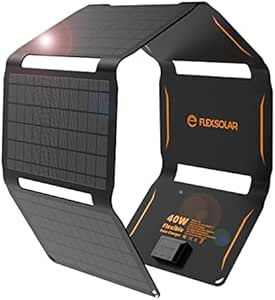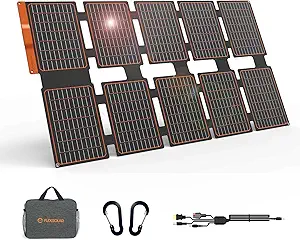Advanced Guide to Portable Solar Chargers for Long-Term Backpacking

Advanced Guide to Portable Solar Chargers for Long-Term Backpacking
Understanding Portable Solar Chargers
The Basics of Solar Charging Technology
Solar chargers convert sunlight into electrical energy through photovoltaic cells. This process, known as the photovoltaic effect, is crucial for backpackers. They rely on solar panels to keep their devices charged in remote locations. The efficiency of a solar charger depends on the quality of the photovoltaic cells and its surface area. Larger panels generally offer more power but come with increased weight and reduced portability.
Common Challenges with Solar Charging
Backpackers often struggle to find the right balance between portability and efficiency. Inconsistent sunlight conditions, such as cloudy weather or shaded areas, can significantly impact the charging process. To overcome these challenges, choosing a solar charger with integrated battery storage can provide a steady power supply, even when direct sunlight isn’t available.
Optimizing Solar Charger Efficiency
To maximize the efficiency of a solar charger, strategic placement is key to ensure maximum sunlight exposure. Solar panels perform best when angled directly towards the sun, which may require periodic adjustment throughout the day. Advanced models often come with built-in kickstands or hanging mechanisms. These features allow for optimal positioning and ease of use.
Key Factors to Consider
Power Output Requirements
The power output of a solar charger, measured in watts (W), determines its charging speed. For efficient charging:
- Smartphones and tablets typically require at least 5W to 10W.
- More demanding equipment, such as laptops, may need 20W or higher.
Assessing your devices’ power requirements before purchasing a solar charger is essential to ensure compatibility and sufficient charging capacity.
Portability vs. Efficiency
Finding the perfect balance between a charger’s size and its charging capability is crucial for backpacking. Considerations include:
- Compact, lightweight chargers are easier to carry but may offer lower efficiency.
- Larger panels provide more power but can be cumbersome to transport.
Consider your packing space and the typical duration of sunlight exposure when choosing the size of your solar charger.
Durability and Weather Resistance
Long-term backpacking exposes solar chargers to harsh conditions. It’s vital to choose a model with a rugged design and weather-resistant features to withstand outdoor adventures. Look for chargers with:
- Durable materials
- Waterproof ratings
- Reinforced ports
These features ensure longevity and reliability.
Types of Portable Solar Chargers
Foldable Solar Panels
Foldable solar panels strike a balance between portability and power, making them a popular choice among backpackers. These chargers can be unfolded to increase their surface area for maximum sunlight absorption, then folded back into a compact size for easy transport. Many foldable models also include built-in battery packs, offering a source of power even when the sun isn’t shining.
Solar Power Banks
Solar power banks combine the convenience of a traditional power bank with solar charging capabilities. While their solar charging speed may not match that of larger panels, they provide the benefit of storing electrical energy. This feature allows you to charge your devices anytime, making solar power banks ideal for backpackers who need a reliable power backup.
Solar Backpacks
Solar backpacks integrate solar panels directly into a backpack, offering convenience and efficiency. These backpacks feature smaller, more durable panels designed for passive charging while hiking. Although they may not provide the same level of power as standalone solar chargers, they’re excellent for keeping devices topped off during long treks.
Enhancing Solar Charger Performance in Various Conditions
Utilizing Weather Apps and Solar Trackers
Modern technology gives backpackers an edge in optimizing solar charger performance. Weather apps can predict sunlight availability, helping you plan your charging sessions more effectively. Solar trackers, though more sophisticated, can automatically adjust the angle of your solar panel throughout the day. These solutions significantly boost your charger’s efficiency, especially in less-than-ideal weather conditions.
Creating a DIY Solar Charging Station
For the tech-savvy backpacker, creating a makeshift solar charging station can be an exciting project. By combining multiple foldable solar panels, you can create a larger, more powerful setup. This approach requires a bit of electrical knowledge but can be a game-changer for long-term expeditions.
Adapting to Low Light Conditions
Inevitably, you’ll encounter situations where sunlight is scarce. In these moments, prioritize which devices need charging most. Use low power modes on smartphones and tablets to extend battery life. Charge power banks during the day to use as a power source at night. This strategy ensures that your most critical devices remain operational.
Maintenance and Care for Longevity
Regular Cleaning and Inspection
The efficiency of your solar charger heavily depends on the cleanliness and integrity of its photovoltaic cells. Regularly wiping the surface with a soft, damp cloth can remove dust, dirt, and other residues. Additionally, inspect your charger for any signs of wear or damage, especially before and after extended trips. This maintenance is crucial for maintaining performance and longevity.
Storage Best Practices
Proper storage is essential to preserve your solar charger’s condition. When not in use, keep it in a cool, dry place away from direct sunlight or extreme temperatures. For foldable models, ensure they’re completely dry before packing to prevent mold and mildew growth. Avoid placing heavy items on top that could damage the panels.
Handling and Transportation
Many solar chargers are designed to withstand outdoor activities, but they’re not indestructible. When packing, place your charger in a central location within your backpack, cushioned by softer items. This careful handling can significantly extend the life of your device, ensuring it remains a reliable power source for many adventures to come.
Advanced Tips for Off-the-Grid Energy Independence
Integrating Solar Power into Your Overall Energy Strategy
For extended stays in the wilderness, integrating solar power into a broader energy strategy is crucial. This might involve using solar panels to charge a larger portable power station. Consider your energy needs and plan accordingly, balancing solar input with your daily power consumption.
Leveraging Power Management Techniques
Effective power management involves understanding the energy consumption patterns of your devices. Using airplane mode on smartphones or low power settings on other gadgets can drastically reduce their energy needs. This allows your solar setup to support more devices or last longer on a single charge.
Emergency Preparedness with Solar Power
Always prepare for the unexpected. This means having backup charging options, such as additional power banks or a secondary, smaller solar charger. It’s also wise to carry basic repair tools and replacement parts for your solar charger. Being prepared can make all the difference in emergency situations, ensuring you remain connected and safe.
By embracing these advanced tips and strategies, you’ll not only maximize the efficiency and longevity of your portable solar charger but also enhance your overall backpacking experience. With the right preparation and knowledge, you can achieve a level of energy independence that brings peace of mind and allows you to fully immerse yourself in the beauty of nature.
Compare Products
Use the arrows to choose products to compare.
| Feature / Product | ELECOM 28W | FlexSolar 40W | Panels 28W | Panels 30W | FlexSolar 100W |
|---|---|---|---|---|---|
 |  |  |  |  | |
| $220.96 | $269.96 | $119.96 | $33.99 | $137.71 | |
| Shop now → | Shop now → | Shop now → | Shop now → | Shop now → | |
| Specifications | |||||
| Brand | ELECOM | FlexSolar | BigBlue | bitnovol | FlexSolar |
| Weight | 771 g | 1.03 kg | 595 g | 1.1 pounds | 4.07 pounds |
| Dimensions | 67 x 28.5 x 1.2 cm; 771 Grams | 123.95 x 27.94 x 0.25 cm; 1.03 kg | 28.45 x 16 x 1.8 cm; 595 Grams | 10.7″L x 7″W x 1.3″H | 12.99″L x 2.17″W x 10.43″H |
| Material | Nylon, PET | ETFE | Monocrystalline Silicon | Monocrystalline Silicon | Monocrystalline Silicon, Aluminum, ETFE |
| Capacity | 5000 Milliamp Hours | N/A | N/A | N/A | N/A |
| Efficiency | High Efficiency | High Efficiency | N/A | ETFE High Efficiency | High Efficiency |
| Waterproof | N/A | Yes | Yes | Yes | Yes |
